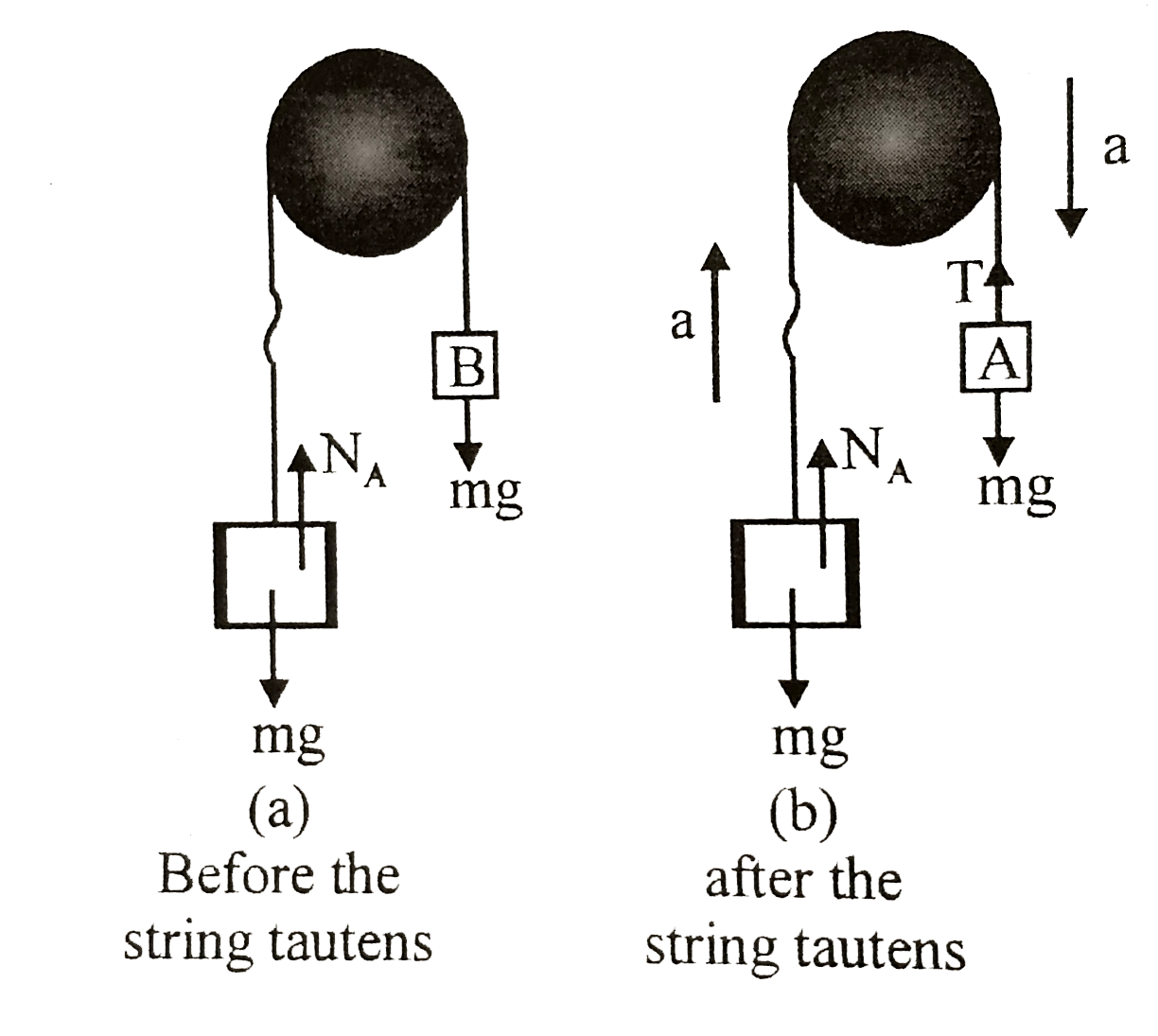After falling from rest through a height h a body of mass m begins to raise a body of mass M(M>m) connected to it through a pulley.
(a) Determine the time it will take for body of mass M to return to its original position.
(b) Find the fraction of kinetic energy lost when the body of mass M is jerked into motion.

(a) The speed of the body B just before the string becomes taut is v=√2gh. When the string is jerked, large impulsive reactions are generated in the string. At this moment effect of gravity is negligible. So momentum of the system is conserved at this instant. Let v' be the common speed of the two bodies after they are jerked into motion. From conservation of momentum, we have
mv=(M+m)v' or v'=mM+mv
The acceleration of the system is
ΣF=Mg−mg=(M+m)a or a=−M−mM+mg
The acceleration is negative, (opposite to v')
Let the system return to origianl position at time t.
0=v't+12at2
or t=−2v'a=2mM−m√2hg
(b) The fractional loss of kinetic energy is
12mv2−12(M+m)v'212mv2=MM+m
Topper's Solved these Questions
- BOOK - BANSALCHAPTER - CENTRE OF MASS & MOMENTUM CONSERVATIONEXERCISE - Practice Exercise20videos
CENTRE OF MASS & MOMENTUM CONSERVATION
- BOOK - BANSALCHAPTER - CENTRE OF MASS & MOMENTUM CONSERVATIONEXERCISE - EXERCISE-1 [SINGLE CORRECT CHOICE TYPE]23videos
CENTRE OF MASS & MOMENTUM CONSERVATION
- BOOK - BANSALCHAPTER - CENTRE OF MASS & MOMENTUM CONSERVATIONEXERCISE - EXERCISE-4 (SECTION-B) (JEE-ADVANCED Previous Year Questions)8videos
CENTRE OF MASS & MOMENTUM CONSERVATION
- BOOK - BANSALCHAPTER - GRAVITATIONEXERCISE - EXERCISE -4 Section - B6videos
GRAVITATION
Similar Questions
After falling from rest through a height h, a body of mass m begins to raise a body of mass M(M>m) connected to it through a pulley. Determnethe time it will take for the body of mass M to return to its original position
View SolutionAfter falling from rest through a height h, a body of mass m begins to raise a body of mass M(M>m) connected to it through a pulley.
Find the fraction of kinetic energy lost when the body of mass M is jerked into motionView Solution
Knowledge Check
- Question 1 - Select One
After falling from rest through a height h, a body of mass m begins to raise a body of mass M(M>m) connected to it through a pulley. Determnethe time it will take for the body of mass M to return to its original position
A2mMm√2hgB2mM−m√2hgC2mM−m√hgDmM−m√2hg - Question 2 - Select One
After falling from rest through a height h, a body of mass m begins to raise a body of mass M(M>m) connected to it through a pulley.
Find the fraction of kinetic energy lost when the body of mass M is jerked into motionAMM+mBMM−mC2MM+mDM2(M+m) - Question 3 - Select One
A body of mass M moves with velocity v and collides elasticity with another body of mass m(M>>m) at rest , then the velocity of the body of mass m is
AvB2vCv/2DZero
What is the gravitational potential energy of a body of mass m at a height h ?
View SolutionA moving body of mass m makes a head on elastic collision with another body of mass 2m which is initially at rest. Find the fraction of kinetic energy lost by the colliding particles after collision.
View SolutionA moving body of mass m makes a head on elastic collision with another body of mass 2m which is initially at rest. Find the fraction of kinetic energy lost by the colliding particles after collision.
View SolutionA body of mass M moves with velocity v and collides elasticity with another body of mass m(M>>m) at rest , then the velocity of the body of mass m is
View SolutionBody A of mass 4m moving with speed u collides with another body B of mass 2m at rest, the collision is head on and elastic in nature. After the collision the fraction of energy lost by colliding body A is :
View Solution

